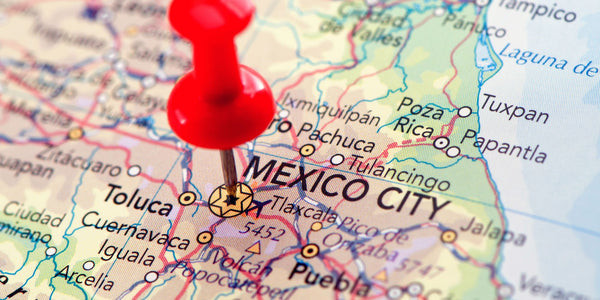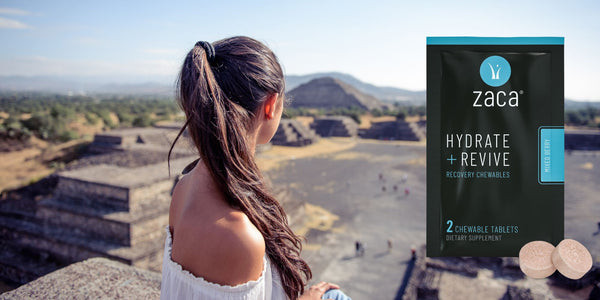Mexico City’s elevation is a significant factor for travelers, especially our LGBTQ+ community heading to Mexico for vibrant culture and experiences. So, Is Mexico City Higher Than Denver? Yes, at 7,349 feet (2,240 meters), Mexico City stands considerably taller than Denver. To ensure a smooth and enjoyable trip, understanding the altitude differences and taking preventive measures against altitude sickness is paramount for everyone. Explore gaymexico.net for more LGBTQ+ travel resources, acclimatization advice, and high-altitude destinations.
1. Understanding Mexico City’s Altitude
Mexico City, one of the world’s highest major cities, sits at an elevation of 7,349 feet (2,240 meters). This height places it above many North American cities, including Denver, Colorado.
Mexico City’s Elevation Explained
- Altitude of Mexico City: 7,349 ft (2,240 m)
With a population exceeding 9 million, Mexico City is the most populous high-altitude city globally. Its location in the Valley of Mexico contributes to its elevated status. Remember, you can always find the best gay-friendly spots on gaymexico.net.
2. Altitude of Popular Destinations Near Mexico City
When planning trips around Mexico City, keep in mind the altitudes of nearby attractions. Many popular destinations also sit at significant heights.
Key Destinations and Their Altitudes
| Destination | Altitude |
|---|---|
| Teotihuacan Pyramids | ~7,500 feet (2,300 m) |
| Toluca | 8,790 feet (2,680 m) |
| Puebla | 7,005 feet (2,135 m) |
| Popocatépetl Volcano | 17,694 feet (5,393 m) |
| Nevado de Toluca | 15,354 feet (4,680 m) |
| Tula (Tula de Allende) | ~6,880 feet (2097 m) |
| Cuernavaca | 4,950 feet (1,510 m) |
| Izta-Popo National Park | Base: 11,200 feet (3,400 m), Peaks: Up to 17,694 feet (5,393 m) |
| Cholula (Great Pyramid) | 7,052 feet (2,149 m) |
| Xochimilco | 7,461 ft (2,274 m) |
These high altitudes pose a risk of altitude sickness, especially for those unaccustomed to such elevations.
3. Altitude Sickness in Mexico City: Is It a Concern?
Yes, altitude sickness can indeed affect visitors to Mexico City due to its high elevation.
Why Altitude Sickness Occurs
The University of Michigan reports that altitude sickness can begin at elevations above 6,000 feet (1,829 meters). Given Mexico City’s altitude of 7,349 feet, the risk is significant, particularly for those arriving from sea level. Even Denver, at 5,280 feet, can cause mild symptoms in some visitors.
4. Symptoms of Altitude Sickness in Mexico City
Mexico City altitude sickness can present various symptoms, ranging from mild to severe.
Common Symptoms to Watch For
- Dizziness
- Headache
- Nausea and vomiting
- Shortness of breath
- Fatigue and weakness
- Insomnia or trouble sleeping
- Loss of appetite
- Swelling of face, hands, or feet
- Irritability
- General feeling of illness
Symptoms can appear within four hours of arrival and may significantly impact your travel experience. Monitor yourself closely between 4-24 hours after arriving.
5. What Causes Altitude Sickness in Mexico City?
The primary cause of altitude sickness is the lower oxygen levels and changes in air pressure at higher elevations. Mexico City has approximately 23% less oxygen than at sea level.
The Body’s Response to High Altitude
When you travel from a low-lying area, your body needs time to adjust to the reduced oxygen levels. This adjustment, known as acclimatization, involves physiological changes that help you adapt. Factors such as age, weight, blood pressure, and respiratory capacity can influence your susceptibility to altitude sickness.
6. Mexico City: A High-Altitude Destination?
 Mexico City View
Mexico City View
Yes, Mexico City is indeed considered a high-altitude city.
Defining High Altitude
Mexico City’s location in the Valley of Mexico, surrounded by mountains and volcanoes, results in its elevation of 7,349 feet. While severe altitude sickness is less common at this height, it can still occur. Mountain Medicine defines high altitude as between 4,900–11,500 feet (1,500–3,500 meters), where oxygen levels drop, and altitude sickness becomes a concern.
7. Six Essential Tips to Avoid Altitude Sickness in Mexico City
Given that Mexico City welcomes over 3 million tourists annually, altitude sickness is a common issue, especially for those not accustomed to high elevations.
Practical Steps for Prevention
- Acclimate Slowly:
- Avoid going directly from sea level to Mexico City.
- Spend several days in Mexico City before traveling to higher altitudes.
- Stay Hydrated:
- Drink plenty of water to combat dehydration.
- Aim for half your body weight in ounces of water daily.
- Avoid Strenuous Activity:
- Refrain from heavy exercise until you’ve acclimatized.
- Rest Adequately:
- Get 7-8 hours of sleep to aid recovery.
- Limit Alcohol:
- Reduce alcohol intake during the first few days.
- Supplement Glutathione:
- Replenish glutathione levels to combat oxidative stress.
By following these tips, you can prepare effectively for the altitude and minimize discomfort.
8. A Tailored Game Plan for LGBTQ+ Travelers in Mexico City
For LGBTQ+ travelers, ensuring a safe and enjoyable trip to Mexico City involves more than just packing your bags; it’s about preparing your body for the altitude while staying connected with the community.
Making the Most of Your Visit
- Stay Informed: Before you arrive, familiarize yourself with LGBTQ+-friendly spots, events, and resources in Mexico City. Websites like gaymexico.net offer comprehensive guides and community insights.
- Health and Safety First: Altitude sickness can affect anyone, so plan your acclimatization carefully. Combine the general tips above with specific health resources tailored for LGBTQ+ travelers, ensuring you know where to find support if needed.
- Connect Locally: Mexico City has a vibrant LGBTQ+ scene. Use online platforms to connect with local groups, find community events, and get insider tips on the best places to visit.
- Respect and Awareness: While Mexico City is generally welcoming, being aware of local customs and attitudes can help ensure a respectful and safe travel experience. Research current social issues and legal protections for LGBTQ+ individuals in Mexico.
With the right preparation, your Mexico City adventure can be both breathtaking and affirming. Enjoy exploring the rich culture, dynamic nightlife, and welcoming community that make this city a unique destination for LGBTQ+ travelers.
9. Embrace Mexico City’s High-Altitude Adventure
Mexico City’s altitude need not dampen your travel plans. With the right knowledge and preparation, you can explore its historic streets, bustling markets, and stunning landscapes with ease.
Your Adventure Awaits
With these tips in mind, you can confidently tackle your Mexico City adventure and breathe easy while doing so. Don’t forget to check out gaymexico.net for more resources and community insights.
10. FAQs About Mexico City Altitude
Let’s address some common questions about Mexico City’s altitude.
Why Is Mexico City So High Up?
Mexico City is situated on a large plateau surrounded by mountains, resulting in its high elevation.
Mexico City Altitude vs Denver?
 Mexico City skyline
Mexico City skyline
There is a 2069 feet (630 meters) difference between Denver and Mexico City.
Comparative Altitudes
- Denver altitude: 5280 ft (1,609 m)
- Mexico City altitude: 7,349 ft (2,240 m)
Mexico City is significantly higher than Denver.
Is Altitude Sickness Common in Mexico City?
Yes, some visitors experience mild altitude sickness, particularly when traveling from lower altitudes.
Is Mexico City The Highest City In The World?
No, other cities like La Paz, Bolivia, and Quito, Ecuador, are at higher altitudes.
Is Mexico City Flat or Hilly?
The city is relatively flat but surrounded by striking hills and mountains.
How Long Does it take to Adjust to Mexico City’s Altitude?
Adjustment can take between 1 and 5 days.
What City In Mexico Has the Highest Altitude?
Toluca is the highest major city in Mexico, sitting at 8,727 feet.
What Should I Take Before a High Altitude Trip?
Consult your doctor about medications like acetazolamide. Supplements like Zaca can also provide natural support.
What’s Mexico City’s Oxygen Level?
Oxygen levels in Mexico City are roughly 75–80% of what they are at sea level.
For LGBTQ+ travelers, Mexico City offers a welcoming and vibrant experience. Visit gaymexico.net to discover gay-friendly accommodations, events, and community resources.
Address: 3255 Wilshire Blvd, Los Angeles, CA 90010, United States. Phone: +1 (213) 380-2177. Website: gaymexico.net.
11. Additional Tips for a Comfortable Stay in Mexico City
To ensure a smooth and enjoyable trip, consider these extra tips:
Dietary Considerations
- Eat Light Meals: Opt for smaller, more frequent meals to ease digestion.
- Avoid Heavy Foods: Limit high-fat and processed foods, which can exacerbate altitude sickness symptoms.
- Embrace Local Cuisine: Sample the diverse and delicious Mexican dishes but be mindful of portion sizes.
Clothing and Gear
- Dress in Layers: Temperature can fluctuate, so wear layers to adjust to changing conditions.
- Sun Protection: High altitude means stronger UV rays. Use sunscreen, sunglasses, and a hat.
- Comfortable Shoes: Pack comfortable walking shoes for exploring the city’s many attractions.
Health and Wellness
- Monitor Your Health: Pay attention to your body and seek medical attention if symptoms worsen.
- Travel Insurance: Ensure you have comprehensive travel insurance that covers altitude sickness.
- Medications: Bring any necessary medications, and consider altitude sickness remedies.
Cultural Etiquette
- Learn Basic Spanish: Knowing a few basic phrases can enhance your interactions with locals.
- Respect Local Customs: Be mindful of cultural norms and traditions.
- Stay Informed: Keep up-to-date with any travel advisories or health recommendations.
Transportation Tips
- Use Reputable Services: Opt for reputable transportation services like Uber or licensed taxis.
- Plan Your Routes: Familiarize yourself with the city’s layout and plan your routes in advance.
- Consider Public Transport: Mexico City has an extensive metro system, but be aware of peak hours.
12. Connecting with the LGBTQ+ Community in Mexico City
Mexico City boasts a thriving LGBTQ+ community, offering numerous opportunities to connect and engage.
Online Resources
- Gaymexico.net: Your go-to source for LGBTQ+ travel information, events, and community insights in Mexico.
- Social Media Groups: Join local LGBTQ+ groups on Facebook and other platforms to connect with residents and fellow travelers.
- Dating Apps: Apps like Grindr, Tinder, and Scruff can help you meet locals and find out about events.
Local Venues and Events
- Zona Rosa: Known as Mexico City’s gay neighborhood, Zona Rosa is packed with gay bars, clubs, and shops.
- Pride Celebrations: Mexico City Pride is one of the largest and most vibrant in Latin America.
- Community Centers: Visit local LGBTQ+ community centers for resources, events, and support.
Safety Tips for LGBTQ+ Travelers
- Be Aware of Your Surroundings: While Mexico City is generally welcoming, it’s always wise to be aware of your surroundings.
- Avoid Public Displays of Affection in Conservative Areas: Exercise discretion in more conservative neighborhoods.
- Trust Your Instincts: If a situation feels unsafe, remove yourself immediately.
13. Must-See Attractions in Mexico City
Mexico City offers a wealth of attractions that cater to diverse interests.
Historical and Cultural Sites
- Templo Mayor: Explore the ruins of the ancient Aztec capital, Tenochtitlan.
- National Museum of Anthropology: Discover Mexico’s rich pre-Hispanic history and culture.
- Palacio de Bellas Artes: Admire the stunning architecture and murals in this cultural landmark.
Parks and Green Spaces
- Chapultepec Park: One of the largest urban parks in the world, offering museums, gardens, and recreational activities.
- Xochimilco Canals: Take a boat ride through the picturesque “floating gardens.”
- Parque México: A beautiful art deco park in the trendy Condesa neighborhood.
Food and Drink
- Street Food: Sample the diverse and delicious street food, from tacos to tamales.
- Mercado Roma: A gourmet food market offering a variety of culinary delights.
- Rooftop Bars: Enjoy stunning city views from one of Mexico City’s many rooftop bars.
Art and Architecture
- Museo Frida Kahlo: Visit the iconic artist’s home and learn about her life and work.
- Coyoacán: Explore the charming colonial neighborhood with its cobblestone streets and colorful buildings.
- Casa Luis Barragán: Tour the home and studio of the renowned Mexican architect.
14. Staying Safe and Healthy in Mexico City
Your well-being is paramount when traveling.
General Safety Tips
- Avoid Walking Alone at Night: Stick to well-lit, populated areas.
- Protect Your Belongings: Be aware of pickpockets and keep valuables secure.
- Use ATMs Wisely: Use ATMs inside banks and be discreet when withdrawing money.
Health Precautions
- Drink Bottled Water: Avoid tap water to prevent stomach issues.
- Wash Your Hands: Wash your hands frequently to prevent the spread of germs.
- Food Safety: Eat at reputable restaurants and avoid street food that looks questionable.
Emergency Contacts
- Emergency Number: 911
- U.S. Embassy: +52 55 5080 2000
- Canadian Embassy: +52 55 5724 7900
15. Resources for LGBTQ+ Travelers in Mexico City
Mexico City provides many resources to ensure LGBTQ+ travelers have a safe, welcoming, and informed experience.
Online Guides and Websites
- Gaymexico.net: Offers a comprehensive guide to LGBTQ+ travel in Mexico, including Mexico City, with information on accommodations, nightlife, events, and community resources.
- Equaldex: Provides up-to-date information on LGBTQ+ rights and laws in Mexico, helping travelers understand the legal landscape.
- Human Rights Watch: Offers reports and insights on human rights issues affecting LGBTQ+ individuals in Mexico, contributing to informed and ethical travel decisions.
Local LGBTQ+ Organizations
- All Out: A global organization that advocates for LGBTQ+ rights. They can provide insights into local issues and campaigns.
- ILGA (International Lesbian, Gay, Bisexual, Trans and Intersex Association): Offers resources and information on LGBTQ+ rights globally, including in Mexico.
- Letra S: A Mexican organization focused on sexual diversity, providing resources and support for LGBTQ+ individuals.
Safety and Emergency Resources
- 911: The general emergency number in Mexico for police, fire, and ambulance services.
- U.S. Embassy in Mexico City: Provides assistance to U.S. citizens, including in cases of emergency. Contact information: +52 55 5080 2000.
- Canadian Embassy in Mexico City: Offers consular services to Canadian citizens. Contact information: +52 55 5724 7900.
Community and Social Groups
- Meetup: Use Meetup to find LGBTQ+ social groups and events in Mexico City.
- Facebook Groups: Join LGBTQ+ community groups on Facebook to connect with locals and other travelers.
Health and Wellness Resources
- Clinics and Hospitals: Identify LGBTQ+-friendly healthcare providers in Mexico City for any medical needs.
- Mental Health Support: Look for resources that offer mental health support for LGBTQ+ individuals, particularly if you experience stress or anxiety during your travels.
By utilizing these resources, LGBTQ+ travelers can enhance their safety, stay informed, and connect with the community in Mexico City. Whether planning your itinerary or needing support during your trip, these resources offer valuable assistance.
Remember to visit gaymexico.net for more detailed information and community insights to make the most of your adventure in Mexico City.
